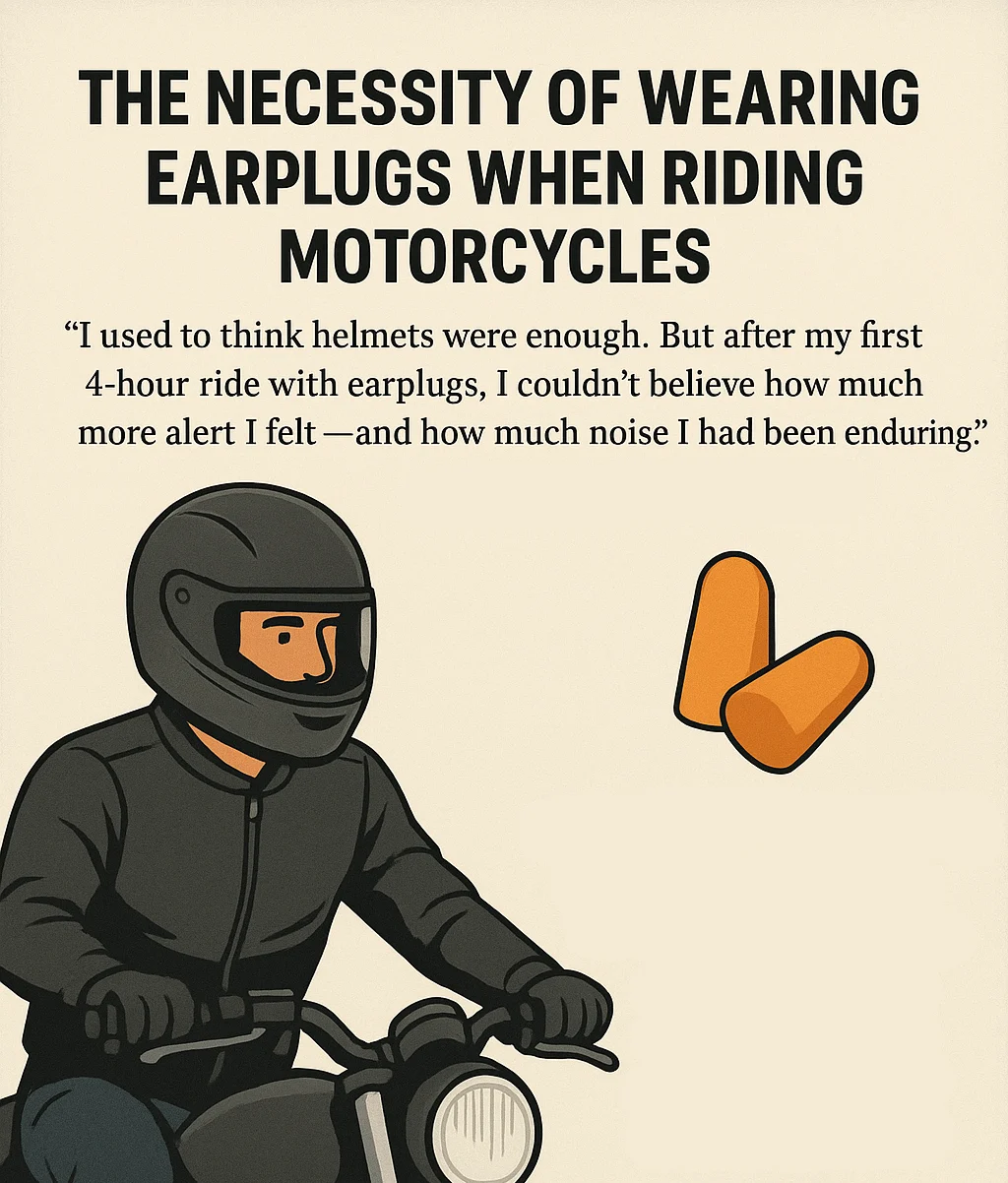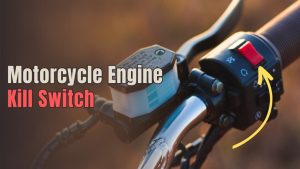🎯 Key Takeaways
- Motorcycle noise can exceed 100 dB, enough to cause hearing damage in under 15 minutes.
- Earplugs reduce wind and engine noise without blocking essential sounds like sirens or horns.
- Using earplugs while riding improves focus, reduces fatigue, and protects long-term hearing health.
- Foam, silicone, filtered, and custom earplugs offer different levels of comfort and protection.
I’ve been riding motorcycles for over a decade, and like most riders, I thought my helmet was all the protection I needed. Wind noise? Just part of the ride. The roaring engine? That’s the thrill, right?
But after a few longer trips, I started noticing something: my ears would ring for hours after a ride. Sometimes, my head felt heavy, like I’d been yelling at a concert all night. I brushed it off as “just fatigue,” but deep down, I knew something wasn’t right.
Then one day, a fellow rider handed me a pair of foam earplugs before a 3-hour group ride. I figured I’d give them a shot.
Game changer.
The ride was quieter, but not in a bad way. I could still hear my engine, traffic, even music in my helmet, but the harsh wind roar was gone. I didn’t feel drained when I got off the bike. My focus was sharper. My ears didn’t ring.
That was the moment I realized: riding without earplugs isn’t tough, it’s reckless.
In this article, I’ll explain you why wearing earplugs on a motorcycles isn’t just smart, it’s essential.
Why Noise Is a Real Threat to Riders

You might think your helmet protects your ears. It doesn’t. In fact, most helmets amplify wind noise inside the shell.
Motorcycle Noise Levels by Speed
| Riding Speed | Wind Noise (dB) | Safe Exposure Time (NIOSH) |
|---|---|---|
| 40 mph | 85 dB | 8 hours |
| 60 mph | 95 dB | 50 minutes |
| 100 mph | 110 dB | Less than 2 minutes |
- A standard motorcycle produces 90–100 dB at cruising speed.
- Wind noise can exceed 115 dB at highway speeds.
- NIOSH states that prolonged exposure above 85 dB causes irreversible hearing damage.
Even short rides without ear protection can cause Temporary Threshold Shift (TTS)—a kind of temporary hearing fatigue that leaves your ears feeling “stuffed” or ringing. Repeated exposure leads to permanent hearing loss and tinnitus.
How Earplugs Protect Your Hearing
Earplugs are small, simple, and incredibly effective. They reduce the volume of harmful noise while still allowing important sounds—like sirens, horns, or engine notes—to come through.
How They Work
Earplugs create a seal inside your ear canal, lowering the intensity of incoming sound waves. They don’t mute sound; they reduce sound pressure to safer levels.
Debunking the Myth
❌ Myth: “Earplugs will make me unaware of traffic around me.”
✅ Fact: The right earplugs reduce harmful noise but still allow you to hear essential sounds. Many riders actually report improved awareness.
The Different Types of Motorcycle Earplugs (And Which You Should Choose)
Choosing the right earplugs depends on your comfort, budget, and riding style.
Comparison Table: Motorcycle Earplug Types
| Type | NRR (dB) | Pros | Cons | Best For |
|---|---|---|---|---|
| Foam | 25–33 | Cheap, high protection, easy to find | Single-use, less breathable | Budget riders, commuters |
| Silicone | 20–30 | Reusable, softer fit | Less noise reduction than foam | Short-distance riders |
| Filtered | 15–25 | Balances protection & clarity, reusable | More expensive, must fit properly | Highway riding, touring |
| Custom-molded | 20–30 | Best fit, highest comfort | Expensive, needs audiologist | Long-distance or daily riders |
Quick Action Checklist for Buying Earplugs
- Buy high-NRR foam or filtered earplugs.
- Test different types to find your fit.
- Wear earplugs every time you ride—even for short trips.
- Clean or replace plugs regularly.
- Educate fellow riders on hearing safety.
Why You Should Wear Earplugs When Riding
Let’s break it down into practical benefits:
1. Prevent Hearing Loss
Motorcycles regularly produce sound levels over 95 dB, especially when paired with wind and traffic. That’s far above what’s safe for long-term exposure.
Earplugs reduce this to safe levels (60–80 dB), drastically lowering your risk of tinnitus, hearing fatigue, and permanent hearing loss.
2. Improve Focus and Road Awareness
Ironically, reducing noise helps you hear better. Wind turbulence inside a helmet creates so much pressure it can mask essential sounds, like sirens or approaching vehicles.
With earplugs, your brain doesn’t have to strain, so you ride more focused and less fatigued.
3. Reduce Fatigue and Vibration Strain
Constant noise and vibration don’t just harm your ears, they exhaust your brain. Long rides become mentally draining. Riders report that using earplugs cuts mental fatigue dramatically, even after multi-hour trips.
4. Ride More Comfortably
Some plugs (especially filtered or custom types) reduce unpleasant wind buffeting inside the helmet, making the ride physically smoother.
How to Use Motorcycle Earplugs Properly
Using earplugs the wrong way reduces their effectiveness and can cause discomfort. Follow these steps:
- Clean your hands before inserting earplugs.
- Roll foam plugs tightly between your fingers before inserting.
- Pull back your ear to open the canal, then insert.
- Hold in place for 20–30 seconds until expanded.
- Replace foam plugs after each use, or clean reusable ones regularly.
FAQs
Is wearing earplugs legal when riding a motorcycle?
There’s generally no federal prohibition against wearing earplugs while riding. However, some state laws interpret them under “headset” restrictions, especially for blocking both ears; always check local vehicle codes.
Do earplugs impair situational awareness?
No. Well-fitted or filtered earplugs often enhance awareness by reducing wind roar, making it easier to perceive critical sounds like sirens or traffic cues.
Which earplug type works best for riders?
Foam plugs offer maximum noise reduction (NRR ~25–33 dB) but can feel muffled. Filtered or custom-plug options deliver balanced protection with better clarity and comfort for extended rides.
Do helmets alone protect your hearing?
No, helmets typically provide only 4–7 dB of noise reduction, which isn’t enough at riding speeds. Combining a helmet with proper earplugs gives significantly better protection.
What NRR rating for earplugs should I choose?
Aim for an NRR of about 20–30 dB: enough to lower harmful noise while preserving essential awareness—real-world effectiveness depends on fit quality.




